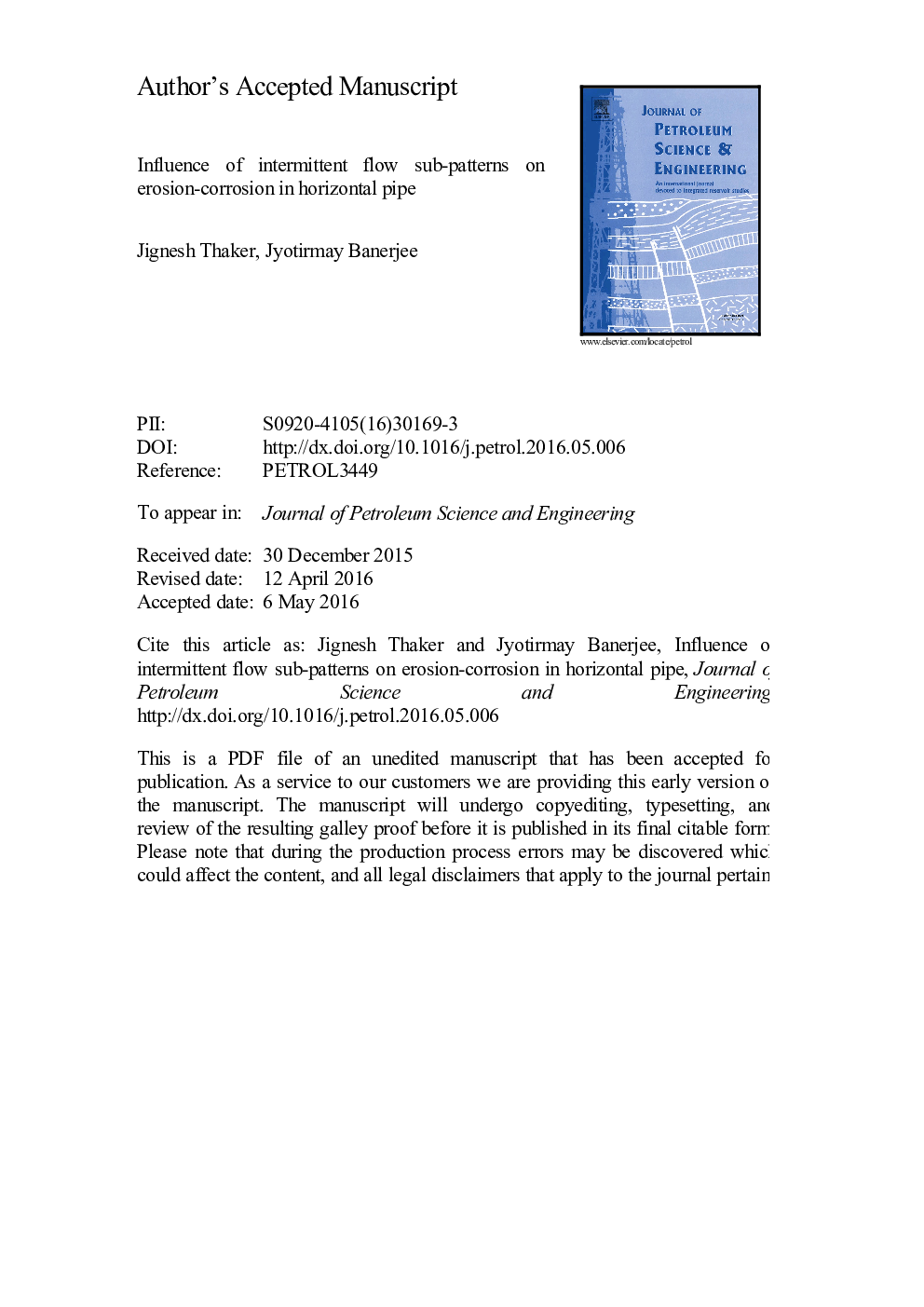| کد مقاله | کد نشریه | سال انتشار | مقاله انگلیسی | نسخه تمام متن |
|---|---|---|---|---|
| 8126112 | 1522796 | 2016 | 48 صفحه PDF | دانلود رایگان |
عنوان انگلیسی مقاله ISI
Influence of intermittent flow sub-patterns on erosion-corrosion in horizontal pipe
ترجمه فارسی عنوان
تأثیر زیر الگوهای جریان متناوب بر خوردگی فرسایش در لوله افقی
دانلود مقاله + سفارش ترجمه
دانلود مقاله ISI انگلیسی
رایگان برای ایرانیان
کلمات کلیدی
جریان متناوب، تجسم جریان، ویژگی های جریان، نقشه ریزساختاری خوردگی،
ترجمه چکیده
ریزش دیواره لوله به علت فرسایش و خوردگی منجر به بسیاری از خرابی های فاجعه بار و زیان های هنگفت اقتصادی در پالایشگاه های نفت (وود و همکاران، 2013) و نیروگاه های هسته ای (احمد، 2012). ساختار متناوب جریان دو فاز از طریق لوله (رگ جریان متناوب) یک عامل مهم برای چنین فرسایش و خوردگی است. تحقیق حاضر تلاش برای ایجاد یک نقشه رژیم است که نشان دهنده پدیده فرسایش و خوردگی می باشد به دلیل جریان های متناوب در لوله. در این راستا، تجربیات تجسم جریان برای سه حالت فرعی مجزا از جریان متناوب انجام می شود یعنی جریان پلاگین با یا بدون لبه حباب، جریان انبساط کمتر هوادهی و جریان جریان انبساطی هوادهی. تصاویری که با سرعت 1600 فریم در ثانیه در 288 قطر پایین ورودی گرفته شده اند، برای تحلیل پویایی ساختار جریان متناوب از نظر گسترش، انقباض، شکستن، تلفات، سقوط و برخورد حباب ها مورد استفاده قرار می گیرند. اندازه گیری های کمی از ویژگی های جریان متناوب (از جمله فرکانس پلاگین / شبیه ساز، سرعت پلاگین / شلنگ و طول پمپ مایع / شلغم) و تاثیر آنها در پدیده خوردگی خوردگی در لوله، به طور کامل گزارش شده است. بر اساس این تجزیه و تحلیل کیفی و کمی، یک نقشه رژیم برای پیش بینی پدیده خوردگی خوردگی در لوله ها به عنوان یک عامل از شرایط جریان ورودی برای هر دو مرحله تعیین می شود. مرزهای گذار برای چهار پدیده فرسایش فرسایش متمایز: فرسایش ناشی از استرس برشی، فرسایش حفره، فرسایش ناشی از تاثیر مایع و خوردگی جریان شتاب در نقشه نشان داده شده است و هشت خط مجزا فرسایش خوردگی نشان داده شده است. نقشه رژیم بر اساس اعداد رینولدز سطحی بی فایده هر دو فاز برای نشان دادن قطر لوله، سرعت جریان و ویسکوزیته مایع ارائه شده است. این نقشه ریزش فرسایش خوردگی در این تحقیق به طور گسترده ای به طراحی موثر سیستم های لوله کشی و بهینه سازی شرایط عملیاتی برای بهره برداری ایمن از پالایشگاه های نفت و نیروگاه های هسته ای کمک خواهد کرد.
موضوعات مرتبط
مهندسی و علوم پایه
علوم زمین و سیارات
زمین شناسی اقتصادی
چکیده انگلیسی
Thinning of pipe wall due to erosion and corrosion has resulted in many catastrophic failures and huge economic losses in petroleum refineries (Wood et al., 2013) and nuclear power stations (Ahmed, 2012). The intermittent structure of two-phase flow through pipe (intermittent flow regime) is an important factor responsible for such erosion and corrosion. The present research is an effort to develop a regime map showing possible erosion and corrosion phenomena due to intermittent flows in pipe. In this direction, flow visualization experiments are carried out for three distinct sub-regimes of intermittent flow namely, plug flow with or without bubble rim, less aerated slug flow and highly aerated slug flow. Images captured at a rate of 1600 frames per second at 288 diameter downstream of inlet are utilised for analysing the dynamics of intermittent flow structure in terms of expansion, contraction, breaking, coalescence, collapse, and collision of bubbles. Quantitative measurements of intermittent flow characteristics (including plug/slug frequency, plug/slug velocity and length of liquid plug/slug) and their influence on erosion-corrosion phenomena in the pipe are reported in detail. Based on these qualitative and quantitative analysis, a regime map for prediction of erosion-corrosion phenomena in pipes is established as a function of inlet flow conditions for both the phases. Transition boundaries for four distinct erosion-corrosion phenomena: shear stress induced erosion, cavitation erosion, liquid impact induced erosion and flow accelerated corrosion are represented in the map and eight distinct regimes of erosion-corrosion are illustrated. The regime map is represented in terms of non-dimensional superficial Reynolds numbers of both the phases to account for pipe diameter, flow rate and fluid viscosity. This erosion-corrosion regime map developed in this research will immensely aid to the effective design of piping systems and optimization of operating conditions for safer operation of petroleum refineries and nuclear power stations.
ناشر
Database: Elsevier - ScienceDirect (ساینس دایرکت)
Journal: Journal of Petroleum Science and Engineering - Volume 145, September 2016, Pages 298-320
Journal: Journal of Petroleum Science and Engineering - Volume 145, September 2016, Pages 298-320
نویسندگان
Jignesh Thaker, Jyotirmay Banerjee,
